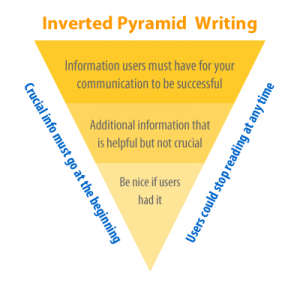
Writing for the web is unlike writing for academic or print publication. A great deal of research has been done on how users interact with web content given various levels of accessibility, device use, age, etc. Certain patterns have emerged and remained true:
- Users skim, rather than read, web content.
- The “inverted pyramid” structure is optimal for prioritizing content.
- “Chunking” content using headings, concise sentences and paragraphs, and bulleted lists makes it more scannable, and therefore more likely to be understood, retained, and acted upon.
- Avoid jargon, abbreviations, acronyms, and unnecessary words in your writing.
These are the most basic tips to help you begin to improve your web writing techniques. Many resources are available via Google search. Some suggestions are provided in the list below.
Additional Resources:
- Clarity and Readability Checklist for Content Creators (Meet Content)
- Writing for the Web (Usability.gov)
- Document Checklist for Plain Language on the Web (PlainLanguage.gov)
- Topic: Writing for the Web (Nielsen Norman Group)
 How is writing for the web different from academic writing?
How is writing for the web different from academic writing?